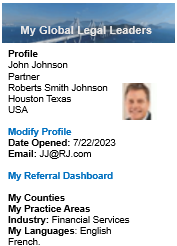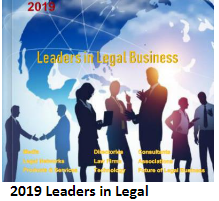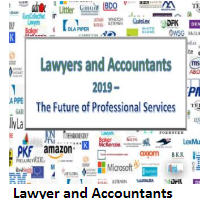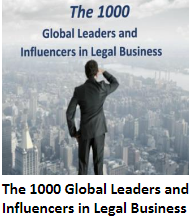Gerry Riskin Principal, Edge International
Gerry Riskin is a
Canadian lawyer and business school graduate with a global reputation as an
author, management consultant, and pioneer in the field of professional firm
economics and marketing. After winning two Queen Elizabeth Scholarships, he
began practicing law in 1973. In 1979, he became a partner with Emery Jamieson
and then in 1984 the managing partner of Snyder & Company.
In 1983, Gerry
co-founded The Edge Group, which in January 2001 evolved into Edge
International. Over
the company’s history it has topped the list in a survey depicting the most
popular marketing consultants by major U.S. firms and has been named one of the
top three legal consultancies by U.S. managing partners.
Gerry has served on the Conference Board of Canada, is a visiting fellow of The College of Law in London, a visiting professor at the University of Pretoria in South Africa, and is a fellow of the College of Law Practice Management.
_______________________________________________________________________________
“We phoned you because we need help,” they’ll say. Those on the other end of this call are typically intelligent, caring lawyers involved in the leadership of their firm. They call with the optimism that maybe you can help. The caution they feel obliged to frequently offer is that the firm had a consultant before, and everyone hated her/him, so it is not clear that it would be safe to bring back another one. Often, I will get a pass because I am a former practicing lawyer and managing partner of an international firm. Maybe I will be safe, after all... It’s far from certain, but possibly worth exploring.
Planning
Planning is a process. Once the leadership has signed off on the process with the optimism that it will attain its objectives, people tend to cooperate to a significant degree because it seems useful enough, and we avoided calling it “strategic planning.”
Executing the Plan
Everything about a law firm rests upon it being able to
achieve its objectives. Individual lawyers are focused on serving their
clients; even quality non-billable initiatives take second or third place.
Executing the plan is like going to the gym. “I bought the membership... Isn’t
that good enough? ... What do you mean, I have to go there? Well, I was going
to go, but a client called.”
The good news is that if you have clarity as to the plan
and leave the lights on (an expression I like to use with my clients, meaning
that they remain aware of where they stand relative to what they want to
achieve), you will find that they are very capable of executing the plan, much
to the delight of everyone involved.
Accomplishments must be tracked. If you ask even the
leadership team what they have achieved over the last year, there is an
uncomfortable restlessness as they try to recall specifics.
Teams that keep a running inventory of achievements have much more self-respect and better internal communications. They also have objective improvements to report, like increased profitability.
Leadership and Management Training
“I'll come to your weekend course if you can teach me to golf like Tiger Woods.” Leadership and management are about taking a group of people for whom you are responsible and making them better than they would have been without you. Yes, managing ferociously independent, critical, and analytical lawyers is worse than herding cats. (Patrick McKenna and I wrote the book “Herding Cats” a long time ago, and I’d be happy to send you a complimentary copy.) Notwithstanding the challenges, leaders who spend some time getting involved with those whom they lead can have a very positive impact on the outcome. In fact, I am aware of a global study that indicates that success is more dependent on the group leader than any other factor.
Training a leader over a weekend is inadequate; the process has to be ongoing for a period of time of a year to 18 months, and has to involve individual feedback based on ongoing performance as a leader.
Performance Enhancement
The
managing partners’ lament, “You don’t tell them anything different from what
I’ve been telling them for years, but for some reason they listen to you.”
(This is where it really helps that I was a managing partner and can completely
empathize.)
Performance
enhancement fails in most firms because of the “knowing versus doing gap.” As
lawyers, we are so cerebral that we think we can solve any problem with the
powers of our minds. A delicious discussion is better than a medieval feast.
In
order to dramatically enhance the performance of an individual, the individual
needs to want to improve. I ask for
firm leaders who are offering performance enhancement training to require an
email application. It is a short email, and the elements are simple. “Tell me
why you want assistance, what you hope to achieve from it, and what the firm
will achieve from it. Please touch on your objectives as you answer these
questions.”
Firm
leaders make the frequent error of saying, “Sally or George really needs this
kind of help... I am going to strongly encourage them.” Sally or George will
succumb to the pressure and then sabotage the process so subtly that they don't
even know they are doing so themselves. Those who show some internal motivation
tend to perform magnificently. I can tell you anecdotally that not all, but
many of the people who are helped in this way increase their performance to a
degree that pleasantly surprises their firms. They also love the process, which
is the polar opposite of sabotaging it.
The elements involved in helping an individual enhance performance include:
1)
Reducing quantifiable objectives to writing;
2)
Exploring whether they need to enhance their substantive expertise;
3)
Determining by whom they wish to be better known and then enhance their
reputation to those constituencies;
4)
Broadening relationships with clients, especially business ones, with whom they
have only one connection; and
5) Helping them present more effectively in all contexts including speaking, writing, responding to RFPs, using social media, and more effectively networking at social functions.
Mergers and Competitive Intelligence
“Should we remain local or regional, or should we merge internationally?” It kind of depends. Many firms need help in assessing their position in their respective marketplaces. Most do not have the tools of competitive intelligence or an understanding of the various contexts in which they are practicing and the options that may be available to them. Some of our most satisfying work is finding information relevant to competition, but also addressing appropriate candidates for lateral hire or merger. This is far too complex a subject to go into in any depth here. Suffice to say that some of my proudest moments are those where I have helped prevent a merger that would have been a disaster or prevented a lateral hire that was a poor choice.
Back to the Future
Working
with the Florida State Bar and its task forces into the future has immersed me
in the disruptive technologies and impact of social media on the legal
profession. We have long had important traditions, but external changes are
coming at us like bombs in a video game. I seek permission and often am allowed
to offer some catalytic information about these changes in order to open the
minds of those with whom I am working to get them thinking about how they might
strategically prepare for a changing future.
The
greatest challenge in advising law firm clients about the future and social
media is that the changes are happening so fast. I keep finding myself saying,
“Well, that was true two years ago...” For example, does each lawyer need to
have a profile on LinkedIn? Five years ago, “no.” Two years ago, “maybe.” Now,
“yes.”
We recently sent some information to some senior litigator clients on an Excel worksheet. We were politely reminded that Excel would be a little difficult for most of them, and we should use Word instead. In essence, we were reminded that many lawyers even in the most sophisticated firms are technologically illiterate. I am not making this up. The challenge, therefore, is to help lawyers in a gentle and empathetic way to see ahead of the bow of their ship so that they can contemplate their future transcending what most lawyers have on their minds today.
The Law Firms that Motivate Consultants
The most exciting law firms to work with have some or many of the following attributes: 1) they have leaders who are willing to lead and are not simply trying to avoid criticism from those who elected them; 2) they are imaginative, and delight in thinking of new practice areas and industry configurations aligned to the changing needs of their marketplaces; and 3) they try. It is impossible to help an athlete who remains slumped in a chair... The athlete has to try and try again and again. This affords a good consultant the opportunity to fine-tune the performance and help the athlete attain great results. Lawyers are athletes, too...
An Acknowledgment to the Sophisticated
Many of the largest firms in the world, including those founded in the United Kingdom, have extraordinary internal management resources and deploy them brilliantly. In fact, my own view is that it is because of them that the legal profession has to raise its game and become far more sophisticated in a great hurry. I have the privilege of serving some of these amazing firms, and I’m very grateful to them for allowing me to help, but also for what I learn from them in the process.

 Software
Software Law
Law Legal
Legal






